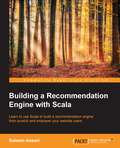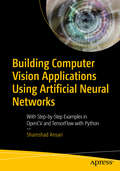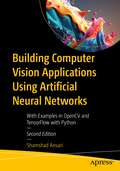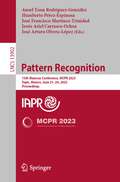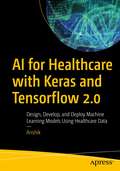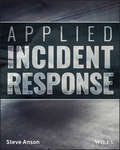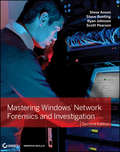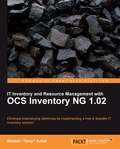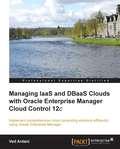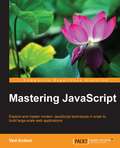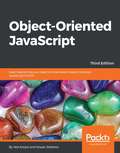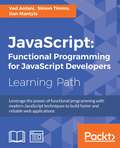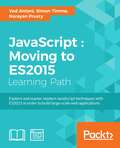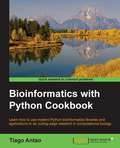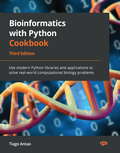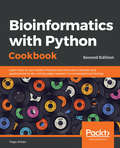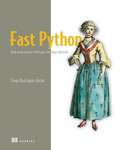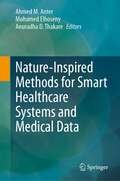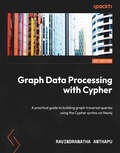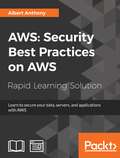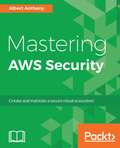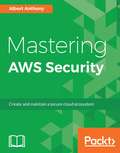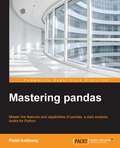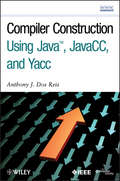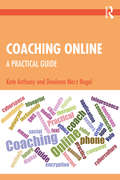- Table View
- List View
Building a Recommendation Engine with Scala
by Saleem AnsariLearn to use Scala to build a recommendation engine from scratch and empower your website usersAbout This BookLearn the basics of a recommendation engine and its application in e-commerceDiscover the tools and machine learning methods required to build a recommendation engineExplore different kinds of recommendation engines using Scala libraries such as MLib and SparkWho This Book Is ForThis book is written for those who want to learn the different tools in the Scala ecosystem to build a recommendation engine. No prior knowledge of Scala or recommendation engines is assumed.What You Will LearnDiscover the tools in the Scala ecosystemUnderstand the challenges faced in e-commerce systems and learn how you can solve those challenges with a recommendation engineFamiliarise yourself with machine learning algorithms provided by the Apache Spark frameworkBuild different versions of recommendation engines from practical code examplesEnhance the user experience by learning from user feedbackDive into the various techniques of recommender systems such as collaborative, content-based, and cross-recommendationsIn DetailWith an increase of data in online e-commerce systems, the challenges in assisting users with narrowing down their search have grown dramatically. The various tools available in the Scala ecosystem enable developers to build a processing pipeline to meet those challenges and create a recommendation system to accelerate business growth and leverage brand advocacy for your clients.This book provides you with the Scala knowledge you need to build a recommendation engine.You'll be introduced to Scala and other related tools to set the stage for the project and familiarise yourself with the different stages in the data processing pipeline, including at which stages you can leverage the power of Scala and related tools. You'll also discover different machine learning algorithms using MLLib.As the book progresses, you will gain detailed knowledge of what constitutes a collaborative filtering based recommendation and explore different methods to improve users' recommendation.Style and approachA step-by-step guide full of real-world, hands-on examples of Scala recommendation engines. Each example is placed in context with explanation and visuals.
Building Computer Vision Applications Using Artificial Neural Networks: With Step-by-Step Examples in OpenCV and TensorFlow with Python
by Shamshad AnsariApply computer vision and machine learning concepts in developing business and industrial applications using a practical, step-by-step approach. The book comprises four main sections starting with setting up your programming environment and configuring your computer with all the prerequisites to run the code examples. Section 1 covers the basics of image and video processing with code examples of how to manipulate and extract useful information from the images. You will mainly use OpenCV with Python to work with examples in this section. Section 2 describes machine learning and neural network concepts as applied to computer vision. You will learn different algorithms of the neural network, such as convolutional neural network (CNN), region-based convolutional neural network (R-CNN), and YOLO. In this section, you will also learn how to train, tune, and manage neural networks for computer vision. Section 3 provides step-by-step examples of developing business and industrial applications, such as facial recognition in video surveillance and surface defect detection in manufacturing. The final section is about training neural networks involving a large number of images on cloud infrastructure, such as Amazon AWS, Google Cloud Platform, and Microsoft Azure. It walks you through the process of training distributed neural networks for computer vision on GPU-based cloud infrastructure. By the time you finish reading Building Computer Vision Applications Using Artificial Neural Networks and working through the code examples, you will have developed some real-world use cases of computer vision with deep learning. What You Will Learn · Employ image processing, manipulation, and feature extraction techniques · Work with various deep learning algorithms for computer vision · Train, manage, and tune hyperparameters of CNNs and object detection models, such as R-CNN, SSD, and YOLO · Build neural network models using Keras and TensorFlow · Discover best practices when implementing computer vision applications in business and industry · Train distributed models on GPU-based cloud infrastructure Who This Book Is For Data scientists, analysts, and machine learning and software engineering professionals with Python programming knowledge.
Building Computer Vision Applications Using Artificial Neural Networks: With Examples in OpenCV and TensorFlow with Python
by Shamshad AnsariComputer vision is constantly evolving, and this book has been updated to reflect new topics that have emerged in the field since the first edition’s publication. All code used in the book has also been fully updated. This second edition features new material covering image manipulation practices, image segmentation, feature extraction, and object identification using real-life scenarios to help reinforce each concept. These topics are essential for building advanced computer vision applications, and you’ll gain a thorough understanding of them. The book’s source code has been updated from TensorFlow 1.x to 2.x, and includes step-by-step examples using both OpenCV and TensorFlow with Python. Upon completing this book, you’ll have the knowledge and skills to build your own computer vision applications using neural networks What You Will Learn Understand image processing, manipulation techniques, and feature extraction methodsWork with convolutional neural networks (CNN), single-shot detector (SSD), and YOLOUtilize large scale model development and cloud infrastructure deploymentGain an overview of FaceNet neural network architecture and develop a facial recognition system Who This Book Is For Those who possess a solid understanding of Python programming and wish to gain an understanding of computer vision and machine learning. It will prove beneficial to data scientists, deep learning experts, and students.
Pattern Recognition: 15th Mexican Conference, MCPR 2023, Tepic, Mexico, June 21–24, 2023, Proceedings (Lecture Notes in Computer Science #13902)
by Ansel Yoan Rodríguez-González Humberto Pérez-Espinosa José Francisco Martínez-Trinidad Jesús Ariel Carrasco-Ochoa José Arturo Olvera-LópezThis book constitutes the refereed proceedings of the 15th Mexican Conference on Pattern Recognition, MCPR 2023, held in Tepic, Mexico, during June 21–24, 2023.The 30 full papers presented in this book were carefully reviewed and selected from 61 submissions. The papers are divided into the following topical sections: pattern recognition and machine learning techniques; deep learning and neural networks; medical applications of pattern recognition; language processing and recognition; and industrial applications of pattern recognition.
AI for Healthcare with Keras and Tensorflow 2.0: Design, Develop, and Deploy Machine Learning Models Using Healthcare Data
by AnshikLearn how AI impacts the healthcare ecosystem through real-life case studies with TensorFlow 2.0 and other machine learning (ML) libraries.This book begins by explaining the dynamics of the healthcare market, including the role of stakeholders such as healthcare professionals, patients, and payers. Then it moves into the case studies. The case studies start with EHR data and how you can account for sub-populations using a multi-task setup when you are working on any downstream task. You also will try to predict ICD-9 codes using the same data. You will study transformer models. And you will be exposed to the challenges of applying modern ML techniques to highly sensitive data in healthcare using federated learning. You will look at semi-supervised approaches that are used in a low training data setting, a case very often observed in specialized domains such as healthcare. You will be introduced to applications of advanced topics such as the graph convolutional network and how you can develop and optimize image analysis pipelines when using 2D and 3D medical images. The concluding section shows you how to build and design a closed-domain Q&A system with paraphrasing, re-ranking, and strong QnA setup. And, lastly, after discussing how web and server technologies have come to make scaling and deploying easy, an ML app is deployed for the world to see with Docker using Flask.By the end of this book, you will have a clear understanding of how the healthcare system works and how to apply ML and deep learning tools and techniques to the healthcare industry.What You Will LearnGet complete, clear, and comprehensive coverage of algorithms and techniques related to case studies Look at different problem areas within the healthcare industry and solve them in a code-first approachExplore and understand advanced topics such as multi-task learning, transformers, and graph convolutional networksUnderstand the industry and learn ML Who This Book Is ForData scientists and software developers interested in machine learning and its application in the healthcare industry
Applied Incident Response
by Steve AnsonIncident response is critical for the active defense of any network, and incident responders need up-to-date, immediately applicable techniques with which to engage the adversary. Applied Incident Response details effective ways to respond to advanced attacks against local and remote network resources, providing proven response techniques and a framework through which to apply them. As a starting point for new incident handlers, or as a technical reference for hardened IR veterans, this book details the latest techniques for responding to threats against your network, including: Preparing your environment for effective incident response Leveraging MITRE ATT&CK and threat intelligence for active network defense Local and remote triage of systems using PowerShell, WMIC, and open-source tools Acquiring RAM and disk images locally and remotely Analyzing RAM with Volatility and Rekall Deep-dive forensic analysis of system drives using open-source or commercial tools Leveraging Security Onion and Elastic Stack for network security monitoring Techniques for log analysis and aggregating high-value logs Static and dynamic analysis of malware with YARA rules, FLARE VM, and Cuckoo Sandbox Detecting and responding to lateral movement techniques, including pass-the-hash, pass-the-ticket, Kerberoasting, malicious use of PowerShell, and many more Effective threat hunting techniques Adversary emulation with Atomic Red Team Improving preventive and detective controls
Mastering Windows Network Forensics and Investigation
by Steven Anson Steve Bunting Ryan Johnson Scott PearsonAn authoritative guide to investigating high-technology crimesInternet crime is seemingly ever on the rise, making the need for a comprehensive resource on how to investigate these crimes even more dire. This professional-level book--aimed at law enforcement personnel, prosecutors, and corporate investigators--provides you with the training you need in order to acquire the sophisticated skills and software solutions to stay one step ahead of computer criminals. Specifies the techniques needed to investigate, analyze, and document a criminal act on a Windows computer or networkPlaces a special emphasis on how to thoroughly investigate criminal activity and now just perform the initial responseWalks you through ways to present technically complicated material in simple terms that will hold up in courtFeatures content fully updated for Windows Server 2008 R2 and Windows 7Covers the emerging field of Windows Mobile forensicsAlso included is a classroom support package to ensure academic adoption, Mastering Windows Network Forensics and Investigation, 2nd Edition offers help for investigating high-technology crimes.
IT Inventory and Resource Management with OCS Inventory NG 1.02
by Barzan Tony AntalThis book closely follows the style of a practical, hands-on "how to" guide on working with OCS Inventory NG. The step-by-step approach, coupled with the use of visual aids, clear instructions, and real-world examples, makes it a fast-paced book. Upon the completion of this book, you will have the necessary skill set, know-how, and confidence to implement OCS Inventory NG to meet the demanding asset management needs of any organization. Then you can carry on using the book as reference material. This book targets an audience of system administrators and IT professionals who are required to implement, configure, customize, and work with IT Inventory and Asset Management solutions. The book does not presume any prior knowledge of inventory management, just a solid grasp of the server/client model and familiarity with the chosen operating system along with the necessary web server and database server terminologies. Anyone with an interest in inventorying IT assets and solving real-world resource management dilemmas will enjoy this book.
Managing IaaS and DBaaS Clouds with Oracle Enterprise Manager Cloud Control 12c
by Ved AntaniThis book is a step-by-step tutorial filled with practical examples which will show readers how to configure and manage IaaS and DBaaS with Oracle Enterprise Manager.If you are a cloud administrator or a user of self-service provisioning systems offered by Enterprise Manager, this book is ideal for you. It will also help administrators who want to understand the chargeback mechanism offered by Enterprise Manager.An understanding of the basic building blocks of cloud computing such as networking, virtualization, storage, and so on, is needed by those of you interested in this book
Mastering JavaScript
by Ved AntaniExplore and master modern JavaScript techniques in order to build large-scale web applications About This Book * Write powerful code with the high-level functions that JavaScript offers * Test and debug issues with JavaScript code using various modern mechanisms * Offers an expert's eye on the latest ES6 features and how these advanced tasks fit together in JavaScript as a whole Who This Book Is For This book is ideal for web developers who are looking to master modern JavaScript concepts and design principles. You should already have an intermediate level of JavaScript knowledge before starting this book. What You Will Learn * Get a run through of the basic JavaScript language constructs * Get familiar with the Functions and Closures of JavaScript * Explore Regular Expressions in JavaScript * Code using the powerful object-oriented feature in JavaScript * Test and debug your code using JavaScript strategies * Master DOM manipulation, cross-browser strategies, and ES6 * Understand the basic concurrency constructs in Javascript and best performance strategies * Learn to build scalable server application in JavaScript using Node.js In Detail JavaScript is a high-level, dynamic, untyped, lightweight, and interpreted programming language. Along with HTML and CSS, it is one of the three essential technologies of World Wide Web content production, and is an open source and cross-platform technology. The majority of websites employ JavaScript, and it is well supported by all modern web browsers without plugins. However, the JavaScript landscape has changed dramatically in recent years, and you need to adapt to the new world of JavaScript that people now expect. Mastering modern JavaScript techniques and the toolchain are essential to develop web-scale applications. Mastering JavaScript will be your companion as you master JavaScript and build innovative web applications. To begin with, you will get familiarized with the language constructs and how to make code easy to organize. You will gain a concrete understanding of variable scoping, loops, and best practices on using types and data structures, as well as the coding style and recommended code organization patterns in JavaScript. The book will also teach you how to use arrays and objects as data structures. You will graduate from intermediate-level skills to advanced techniques as you come to understand crucial language concepts and design principles. You will learn about modern libraries and tools so you can write better code. By the end of the book, you will understand how reactive JavaScript is going to be the new paradigm. Style and approach This is a comprehensive guide with a clear focus on practical use cases and patterns. Each chapter consists of best practices, useful advice, and a bunch of easy-to-follow examples that will build up your skills as you advance through the book.
Object-Oriented JavaScript - Third Edition
by Ved Antani Stoyan StefanovLearn everything you need to know about object-oriented JavaScript with this comprehensive guide. Enter the world of cutting-edge development! About This Book • This book has been updated to cover all the new object-oriented features introduced in ECMAScript 6 • It makes object-oriented programming accessible and understandable to web developers • Write better and more maintainable JavaScript code while exploring interactive examples that can be used in your own scripts Who This Book Is For This book is ideal for new to intermediate JavaScript developers who want to prepare themselves for web development problems solved by object-oriented JavaScript! What You Will Learn • Apply the basics of object-oriented programming in the JavaScript environment • Use a JavaScript Console with complete mastery • Make your programs cleaner, faster, and compatible with other programs and libraries • Get familiar with Iterators and Generators, the new features added in ES6 • Find out about ECMAScript 6's Arrow functions, and make them your own • Understand objects in Google Chrome developer tools and how to use them • Use a mix of prototypal inheritance and copying properties in your workflow • Apply reactive programming techniques while coding in JavaScript In Detail JavaScript is an object-oriented programming language that is used for website development. Web pages developed today currently follow a paradigm that has three clearly distinguishable parts: content (HTML), presentation (CSS), and behavior (JavaScript). JavaScript is one important pillar in this paradigm, and is responsible for the running of the web pages. This book will take your JavaScript skills to a new level of sophistication and get you prepared for your journey through professional web development. Updated for ES6, this book covers everything you will need to unleash the power of object-oriented programming in JavaScript while building professional web applications. The book begins with the basics of object-oriented programming in JavaScript and then gradually progresses to cover functions, objects, and prototypes, and how these concepts can be used to make your programs cleaner, more maintainable, faster, and compatible with other programs/libraries. By the end of the book, you will have learned how to incorporate object-oriented programming in your web development workflow to build professional JavaScript applications. Style and approach Filled with practical instructions, the book shows you how to implement object-oriented features of JavaScript in the real world. The to-the-point nature of the book will benefit developers who are looking for a fast-paced guide to learn object-oriented JavaScript.
JavaScript: Functional Programming for JavaScript Developers
by Ved Antani Simon Timms Dan Mantyla<P><P>About This Book <P><P>Write powerful code with the high-level functions that JavaScript offers <P><P>Discover what functional programming is, why it's effective, and how it's used in JavaScript <P><P>Understand and optimize JavaScript's hidden potential as a true functional language <P><P>Who This Book Is For <P><P>If you are a JavaScript developer interested in learning functional programming, looking for the quantum leap toward mastering the JavaScript language, or just want to become a better programmer in general, then this book is ideal for you. This guide is aimed at programmers, involved in developing reactive frontend apps, server-side apps that wrangle with reliability and concurrency, and everything in between. <P><P>What You Will Learn <P><P>Get a run through of the basic JavaScript language constructs <P><P>Code using the powerful object-oriented features in JavaScript <P><P>Master DOM manipulation, cross-browser strategies, and ES6 <P><P>Understand the basic concurrency constructs in JavaScript and best performance strategies <P><P>Harness the power of patterns for tasks ranging from application building to code testing <P><P>Build large-scale apps seamlessly with the help of reactive patterns <P><P>Explore advanced design patterns, including dependency injection <P><P>Develop more powerful applications with currying and function composition <P><P>Create more reliable code with closures and immutable data <P><P>In Detail <P><P>JavaScript is a high-level, dynamic, untyped, lightweight, and interpreted programming language, and functional programming is a style that emphasizes and enables smarter code, minimizing complexity and increasing modularity. <P><P>This course will take you on a journey that shows how functional programming, when combined with other techniques, makes JavaScript programming more efficient. The first module stresses the practical aspects of JavaScript development, including everything that a modern JavaScript project will need. <P><P>The second module explores how design patterns can help you improve and organize your JavaScript code. You'll get to grips with creational, structural, and behavioral patterns as you discover how to put them to work in different scenarios. <P><P>The third module will help you to write real-world applications by utilizing a wide range of functional techniques and styles. It explores the core concepts of functional programming common to all functional languages, with examples of their use in JavaScript.
JavaScript: Moving to ES2015
by Ved Antani Simon Timms Narayan PrustyExplore and master modern JavaScript techniques with ES2015 in order to build large-scale web applications About This Book • This course offers an expert's eye on the latest ES6 features and how these advanced tasks fit together in JavaScript as a whole • Discover robust JavaScript implementations of classic and advanced design patterns • Learn about modern web architectures and build real-world apps on top of them Who This Book Is For This course is for experienced developers familiar with other object-oriented languages who wants to learn new capabilities of ES-2015 to improve their web development skills and build professional-quality web applications. This also goes for those who want to explore some modern JavaScript features, techniques, and architectures in order to develop cutting-edge web applications. What You Will Learn • Get a run through of the basic language constructs, Functions, and Closures of JavaScript • Code using the powerful object-oriented feature in JavaScript • Master DOM manipulation, cross-browser strategies, and ES6 • Harness the power of patterns for tasks ranging from application building to code testing • Identify the best use cases for microservices • Gain expertise in responsive and dynamic website design • Enable real-time communications between client-client and client-server/server-client • Write complete applications using functional reactive programming In Detail JavaScript is a high-level, dynamic, untyped, lightweight, and interpreted programming language. Mastering modern JavaScript techniques and the toolchain are essential to develop web-scale applications. This Learning Path will upgrade your skills to ES2015, and you will get to introduce yourself to popular frameworks like React and Angular 2. In the first module, you will get familiar with the language constructs and how to make code easy to organize. You will gain a concrete understanding of variable scoping, loops, and best practices on using types and data structures, as well as the coding style and recommended code organization patterns in JavaScript. By the end of the module, you will understand how reactive JavaScript is going to be the new paradigm. Over the course of the next module, you will explore how design patterns can help you improve and organize your JavaScript code. You'll get to grips with creational, structural, and behavioral patterns and get a deeper look at patterns used in functional programming, as well as model view patterns and patterns to build web applications. By the end of the module, you'll be saved of a lot of trial and error and developmental headaches, and you will be on the road to becoming a JavaScript expert. In the last leg of this course, you will shift your focus to network programming concepts as you build a real-time web application with websockets. Along the way, you'll explore how the power of JavaScript can be increased multi-fold with high performance techniques. By the end of this module, you'll be a skilled JavaScript developer with a solid knowledge of the latest JavaScript techniques, tools, and architecture to build modern web apps. This Learning Path combines some of the best that Packt has to offer in one complete, curated package. It includes content from the following Packt products: • Mastering JavaScript by Ved Antani • Mastering JavaScript Design Patterns, Second Edition by Simon Timms • Modern JavaScript Applications by Narayan Prusty Style and approach This course is a comprehensive guide with a clear focus on practical use cases and patterns. Each chapter consists of best practices, useful advice, and a bunch of easy-to-follow examples that will build up your skills as you advance.
Bioinformatics with Python Cookbook
by Tiago AntaoIf you have intermediate-level knowledge of Python and are well aware of the main research and vocabulary in your bioinformatics topic of interest, this book will help you develop your knowledge further.
Bioinformatics with Python Cookbook: Use modern Python libraries and applications to solve real-world computational biology problems, 3rd Edition
by Tiago AntaoDiscover modern, next-generation sequencing libraries from the powerful Python ecosystem to perform cutting-edge research and analyze large amounts of biological dataKey FeaturesPerform complex bioinformatics analysis using the most essential Python libraries and applicationsImplement next-generation sequencing, metagenomics, automating analysis, population genetics, and much moreExplore various statistical and machine learning techniques for bioinformatics data analysisBook DescriptionBioinformatics is an active research field that uses a range of simple-to-advanced computations to extract valuable information from biological data, and this book will show you how to manage these tasks using Python.This updated third edition of the Bioinformatics with Python Cookbook begins with a quick overview of the various tools and libraries in the Python ecosystem that will help you convert, analyze, and visualize biological datasets. Next, you'll cover key techniques for next-generation sequencing, single-cell analysis, genomics, metagenomics, population genetics, phylogenetics, and proteomics with the help of real-world examples. You'll learn how to work with important pipeline systems, such as Galaxy servers and Snakemake, and understand the various modules in Python for functional and asynchronous programming. This book will also help you explore topics such as SNP discovery using statistical approaches under high-performance computing frameworks, including Dask and Spark. In addition to this, you'll explore the application of machine learning algorithms in bioinformatics.By the end of this bioinformatics Python book, you'll be equipped with the knowledge you need to implement the latest programming techniques and frameworks, empowering you to deal with bioinformatics data on every scale.What you will learnBecome well-versed with data processing libraries such as NumPy, pandas, arrow, and zarr in the context of bioinformatic analysisInteract with genomic databasesSolve real-world problems in the fields of population genetics, phylogenetics, and proteomicsBuild bioinformatics pipelines using a Galaxy server and SnakemakeWork with functools and itertools for functional programmingPerform parallel processing with Dask on biological dataExplore principal component analysis (PCA) techniques with scikit-learnWho this book is forThis book is for bioinformatics analysts, data scientists, computational biologists, researchers, and Python developers who want to address intermediate-to-advanced biological and bioinformatics problems. Working knowledge of the Python programming language is expected. Basic knowledge of biology will also be helpful.
Bioinformatics with Python Cookbook - Second Edition
by Tiago AntaoThis book is for Data Scientists, Bioinformatics analysts, researchers, and Python developers who want to address intermediate-to-advanced common biological and bioinformatics problems with the recipe-based approach. Working knowledge of Python programming language is expected.
Fast Python: High performance techniques for large datasets
by Tiago AntaoMaster Python techniques and libraries to reduce run times, efficiently handle huge datasets, and optimize execution for complex machine learning applications. Fast Python is a toolbox of techniques for high performance Python including: Writing efficient pure-Python code Optimizing the NumPy and pandas libraries Rewriting critical code in Cython Designing persistent data structures Tailoring code for different architectures Implementing Python GPU computing Fast Python is your guide to optimizing every part of your Python-based data analysis process, from the pure Python code you write to managing the resources of modern hardware and GPUs. You'll learn to rewrite inefficient data structures, improve underperforming code with multithreading, and simplify your datasets without sacrificing accuracy. Written for experienced practitioners, this book dives right into practical solutions for improving computation and storage efficiency. You'll experiment with fun and interesting examples such as rewriting games in Cython and implementing a MapReduce framework from scratch. Finally, you'll go deep into Python GPU computing and learn how modern hardware has rehabilitated some former antipatterns and made counterintuitive ideas the most efficient way of working. About the Technology Face it. Slow code will kill a big data project. Fast pure-Python code, optimized libraries, and fully utilized multiprocessor hardware are the price of entry for machine learning and large-scale data analysis. What you need are reliable solutions that respond faster to computing requirements while using less resources, and saving money. About the Book Fast Python is a toolbox of techniques for speeding up Python, with an emphasis on big data applications. Following the clear examples and precisely articulated details, you&’ll learn how to use common libraries like NumPy and pandas in more performant ways and transform data for efficient storage and I/O. More importantly, Fast Python takes a holistic approach to performance, so you&’ll see how to optimize the whole system, from code to architecture. What&’s Inside Rewriting critical code in Cython Designing persistent data structures Tailoring code for different architectures Implementing Python GPU computing About the Reader For intermediate Python programmers familiar with the basics of concurrency. About the Author Tiago Antão is one of the co-authors of Biopython, a major bioinformatics package written in Python. Table of Contents: PART 1 - FOUNDATIONAL APPROACHES 1 An urgent need for efficiency in data processing 2 Extracting maximum performance from built-in features 3 Concurrency, parallelism, and asynchronous processing 4 High-performance NumPy PART 2 - HARDWARE 5 Re-implementing critical code with Cython 6 Memory hierarchy, storage, and networking PART 3 - APPLICATIONS AND LIBRARIES FOR MODERN DATA PROCESSING 7 High-performance pandas and Apache Arrow 8 Storing big data PART 4 - ADVANCED TOPICS 9 Data analysis using GPU computing 10 Analyzing big data with Dask
Nature-Inspired Methods for Smart Healthcare Systems and Medical Data
by Ahmed M. Anter Mohamed Elhoseny Anuradha D. ThakareThis book aims to gather high-quality research papers on developing theories, frameworks, architectures, and algorithms for solving complex challenges in smart healthcare applications for real industry use. It explores the recent theoretical and practical applications of metaheuristics and optimization in various smart healthcare contexts. The book also discusses the capability of optimization techniques to obtain optimal parameters in ML and DL technologies. It provides an open platform for academics and engineers to share their unique ideas and investigate the potential convergence of existing systems and advanced metaheuristic algorithms. The book's outcome will enable decision-makers and practitioners to select suitable optimization approaches for scheduling patients in crowded environments with minimized human errors.The healthcare system aims to improve the lives of disabled, elderly, sick individuals, and children. IoT-based systems simplify decision-making and task automation, offering an automated foundation. Nature-inspired metaheuristics and mining algorithms are crucial for healthcare applications, reducing costs, increasing efficiency, enabling accurate data analysis, and enhancing patient care. Metaheuristics improve algorithm performance and address challenges in data mining and ML, making them essential in healthcare research. Real-time IoT-based healthcare systems can be modeled using an IoT-based metaheuristic approach to generate optimal solutions.Metaheuristics are powerful technologies for optimization problems in healthcare systems. They balance exact methods, which guarantee optimal solutions but require significant computational resources, with fast but low-quality greedy methods. Metaheuristic algorithms find better solutions while minimizing computational time. The scientific community is increasingly interested in metaheuristics, incorporating techniques from AI, operations research, and soft computing. New metaheuristics offer efficient ways to address optimization problems and tackle unsolved challenges. They can be parameterized to control performance and adjust the trade-off between solution quality and resource utilization. Metaheuristics manage the trade-off between performance and solution quality, making them highly applicable to real-time applications with pragmatic objectives.
Graph Data Processing with Cypher: A practical guide to building graph traversal queries using the Cypher syntax on Neo4j
by Ravindranatha AnthapuGet acquainted with Cypher in a guided manner quickly and learn how to query the graph databases with efficient and performant queriesKey FeaturesWork with Cypher syntax and semantics while building graph traversal queriesGet up and running with advanced Cypher concepts like List, Maps, OPTIONAL MATCHMaster best practices in writing effective queries leveraging data modeling and patternsBook DescriptionWhile it is easy to learn and understand the Cypher declarative language for querying graph databases, it can be very difficult to master it. As graph databases are becoming more mainstream, there is a dearth of content and guidance for developers to leverage database capabilities fully. This book fills the information gap by describing graph traversal patterns in a simple and readable way.This book provides a guided tour of Cypher from understanding the syntax, building a graph data model, and loading the data into graphs to building queries and profiling the queries for best performance. It introduces APOC utilities that can augment Cypher queries to build complex queries. You'll also be introduced to visualization tools such as Bloom to get the most out of the graph when presenting the results to the end users.After having worked through this book, you'll have become a seasoned Cypher query developer with a good understanding of the query language and how to use it for the best performance.What you will learnWrite Cypher queries from basic to advanced levelMap the source data to the graph data model in an iterative fashionLoad the data into a graph using LOAD CSV, APOC, and client driversMap the business questions to graph queries effectivelyIdentify query performance issues and fix themExtend capabilities of Cypher using APOC utilitiesWork with graph visualization tools like Bloom and BrowserWho this book is forThis book is targeted at Database Administrator, Database Developers, Graph Database Developers, and Graph Database Architects. This book will also help someone migrate from a DBA role to a graph data engineer or data scientistIf you are working with graph databases and need to learn Cypher, or are a basic Cypher developer who wants to get better at data modeling and tuning queries to build performant Cypher queries, then this is the book for you.
AWS: Learn to secure your data, servers, and applications with AWS
by Albert AnthonyDelve deep into various security aspects of AWS to build and maintain a secured environmentKey Features●Learn to secure your network, infrastructure, data, and applications in AWS cloud●Use AWS managed security services to automate security●Dive deep into various aspects such as the security model, compliance, access management and much more to build and maintain a secured environment●Explore Cloud Adoption Framework (CAF) and its components●Embedded with assessments that will help you revise the concepts you have learned in this bookBook DescriptionWith organizations moving their workloads, applications, and infrastructure to the cloud at an unprecedented pace, security of all these resources has been a paradigm shift for all those who are responsible for security; experts, novices, and apprentices alike.This book focuses on using native AWS security features and managed AWS services to help you achieve continuous security. Starting with an introduction to Virtual Private Cloud (VPC) to secure your AWS VPC, you will quickly explore various components that make up VPC such as subnets, security groups, various gateways, and many more.You will also learn to protect data in the AWS platform for various AWS services by encrypting and decrypting data in AWS. You will also learn to secure web and mobile applications in AWS cloud.This book is ideal for all IT professionals, system administrators, security analysts, solution architects, and chief information security officers who are responsible for securing workloads in AWS for their organizations.This book is embedded with useful assessments that will help you revise the concepts you have learned in this book.What you will learn●Get familiar with VPC components, features, and benefits●Learn to create and secure your private network in AWS●Explore encryption and decryption fundamentals●Understand monitoring, logging, and auditing in AWS●Ensure data security in AWS●Secure your web and mobile applications in AWS●Learn security best practices for IAM, VPC, shared security responsibility model, and so onWho this book is forThis book is for all IT professionals, system administrators, security analysts, solution architects, and chief information security officers who are responsible for securing workloads in AWS for their organizations.
Mastering AWS Security
by Albert Anthony<P><P>An informative guide to implementing and using AWS security services effectively <P><P>About This Book <P><P>Learn to secure your network, infrastructure, data and applications in AWS cloud <P><P>Log, monitor and audit your AWS resources for continuous security and continuous compliance in AWS cloud <P><P>Use AWS managed security services to automate security, and focus on your business rather than being distracted by security risks and issues with AWS security <P><P>Cover topics including the security model, compliance, access management and much more to build and maintain a secure environment <P><P>Who This Book Is For <P><P>This book is for all IT professionals, system administrators and security analysts, solution architects and Chief Information Security Officers who are responsible for securing workloads in AWS for their organizations. Master AWS Security is helpful for all Solutions Architects who want to design and implement secure architecture on AWS by the following security by design principle, and is beneficial for personnel in Auditors and Project Management roles who want to understand how they can audit AWS workloads and manage security in AWS. <P><P>If you're learning AWS or championing AWS adoption in your organization, you should read this book to build security in all your workloads. You'll benefit from understanding the security footprint of all major AWS services for multiple domains, use cases, and scenarios. <P><P>What You Will Learn <P><P>Learn about AWS Identity Management and Access control <P><P>Gain knowledge to create and secure your private network in AWS <P><P>Understand and secure your infrastructure in AWS <P><P>Understand monitoring, logging and auditing in AWS <P><P>Ensure Data Security in AWS <P><P>Learn to secure your applications in AWS <P><P>Explore AWS Security best practices <P><P>In Detail <P><P>Mastering AWS Security starts with an exploration of the fundamentals of the shared security responsibility model. This book tells you how you can enable continuous security, continuous auditing, and continuous compliance by automating security in AWS with the tools, services, and features available. <P><P>Moving on, you'll learn about access control in AWS for all resources. You'll also cover the security of your network, servers, data and applications in the AWS cloud using native AWS security services. <P><P>By the end of this book, you will understand the complete AWS Security landscape, covering all aspects of end-to-end software and hardware security along with logging, auditing, and compliance of your entire IT environment in the AWS cloud. <P><P>Lastly, Mastering AWS Security wraps up with AWS best practices for security.
Mastering AWS Security
by Albert AnthonyIn depth informative guide to implement and use AWS security services effectively. About This Book • Learn to secure your network, infrastructure, data and applications in AWS cloud • Log, monitor and audit your AWS resources for continuous security and continuous compliance in AWS cloud • Use AWS managed security services to automate security. Focus on increasing your business rather than being diverged onto security risks and issues with AWS security. • Delve deep into various aspects such as the security model, compliance, access management and much more to build and maintain a secure environment. Who This Book Is For This book is for all IT professionals, system administrators and security analysts, solution architects and Chief Information Security Officers who are responsible for securing workloads in AWS for their organizations. It is helpful for all Solutions Architects who want to design and implement secure architecture on AWS by the following security by design principle. This book is helpful for personnel in Auditors and Project Management role to understand how they can audit AWS workloads and how they can manage security in AWS respectively. If you are learning AWS or championing AWS adoption in your organization, you should read this book to build security in all your workloads. You will benefit from knowing about security footprint of all major AWS services for multiple domains, use cases, and scenarios. What You Will Learn • Learn about AWS Identity Management and Access control • Gain knowledge to create and secure your private network in AWS • Understand and secure your infrastructure in AWS • Understand monitoring, logging and auditing in AWS • Ensure Data Security in AWS • Learn to secure your applications in AWS • Explore AWS Security best practices In Detail Mastering AWS Security starts with a deep dive into the fundamentals of the shared security responsibility model. This book tells you how you can enable continuous security, continuous auditing, and continuous compliance by automating your security in AWS with the tools, services, and features it provides. Moving on, you will learn about access control in AWS for all resources. You will also learn about the security of your network, servers, data and applications in the AWS cloud using native AWS security services. By the end of this book, you will understand the complete AWS Security landscape, covering all aspects of end - to -end software and hardware security along with logging, auditing, and compliance of your entire IT environment in the AWS cloud. Lastly, the book will wrap up with AWS best practices for security. Style and approach The book will take a practical approach delving into different aspects of AWS security to help you become a master of it. It will focus on using native AWS security features and managed AWS services to help you achieve continuous security and continuous compliance.
Mastering pandas
by Femi AnthonyThis book is intended for Python programmers, mathematicians, and analysts who already have a basic understanding of Python and wish to learn about its data analysis capabilities in depth.
Compiler Construction Using Java, JavaCC, and Yacc
by Anthony J. Dos ReisBroad in scope, involving theory, the application of that theory, and programming technology, compiler construction is a moving target, with constant advances in compiler technology taking place. Today, a renewed focus on do-it-yourself programming makes a quality textbook on compilers, that both students and instructors will enjoy using, of even more vital importance. This book covers every topic essential to learning compilers from the ground up and is accompanied by a powerful and flexible software package for evaluating projects, as well as several tutorials, well-defined projects, and test cases.
Coaching Online: A Practical Guide
by Kate Anthony DeeAnna Merz NagelTranslating traditional coaching methods and competencies for use in the online world, this informative and timely guide shows coaches how to transform their face-to-face practice into one that utilises technological means of communication with clients, mentors, and everyone else associated with their practice. The book offers up-to-the-minute practical and ethical information from two world-expert coaches, leaning on their combined 50 years of experience and study. It covers the practice of online coaching via email, chat, audio/telephone and video methods, as well as the ethics of online coaching (including an ethical framework), case material, supervision, mentoring and training, and a look into the future of the coaching profession in light of technological developments and the culture of cyberspace. Whether you are a coach-in-training or established Coaching Master, this book is an accessible and invaluable tool for taking and maintaining your coaching services online.
